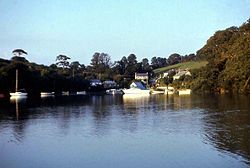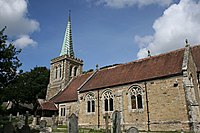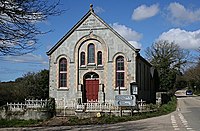Kea
| Kea Cornish: Sen Ke | |
| Cornwall | |
|---|---|
 Coombe, Kea | |
| Location | |
| Grid reference: | SW810427 |
| Location: | 50°14’35"N, 5°4’23"W |
| Data | |
| Population: | 1,580 (2011) |
| Post town: | Truro |
| Postcode: | TR3 |
| Dialling code: | 01872 |
| Local Government | |
| Council: | Cornwall |
| Parliamentary constituency: |
South East Cornwall |
Kea is a village in Cornwall. It is a large straggling parish[1] in the former mining area south of Truro: Kea is to be found just over a mile southwest of Truro.
Old Kea is two miles to the east on the west bank of the Truro River at SW843417, and it is here that St Kea is reputedly to have landed on his first visit to Cornwall, at which time he established a church at Old Kea, which was the parish church until replaced by All Hallows.
Today, the parish is mainly agricultural, and is noted for giving its name to the damson-type Kea plum. It is bounded to the north by Calenick Creek and Truro civil parish; to the east by the Truro River and River Fal; to the south by the parishes of Feock, Perranarworthal and Gwennap; and to the west by Kenwyn.[1] Other settlements in the parish include Calenick, Come-to-Good, Killiow, Nansavallan, Playing Place and Porth Kea.
Kea was described in 1870–72, John Marius Wilson's Imperial Gazetteer of England and Wales (1870) as:
A parish and a sub-district in Truro district, Cornwall. The parish lies on the Falmouth and Redruth railways, 2¼ miles SSW of Truro; is bounded, on the E, by the river Fal, on the N, by Kenwyn, on the W, by Gwennap; and contains parts of the chapelries of Baldhu, Chacewater, and Mithian. Real property £7,158 of which £1,234 are in mines. Pop(ulation) in 1861 3,949. Houses, 824. The manor belongs to Viscount Falmouth.[2]
Churches and schools


All Hallows church is in Kea village. It was built in 1895 to replace a church of 1802 which was the work of James Wyatt. The church has a steep tiled roof and a lead spire. The font is Norman and of the Altarnun type.[3] This present church was consecrated 4 June 1896.[1]
The church of St Kea at Old Kea was the parish church until All Hallows was built. Later, the church at Old Kea was pulled down and only the tower remains today.[1] A small chapel now stands beside the ruined mediæval tower and services are held there twice a month[4]
A Quaker Meeting House opened in Come-to-Good, in Kea parish, in 1710.
Kea Monastery was a monastery probably at Kea of which little is known. "The mysterious land-owning monastery of St Cheus mentioned in Domesday (in Powder), 1085, possibly refers to Kea."—Charles Henderson, in Cornish Church Guide, 1925, p. 116.
There is a school in the parish, Kea Community Primary School, which caters for 200 pupils of primary school age.
Houses
At Calenick and Killiow are 18th-century houses of two storeys. Calenick House contains remains of a much older building; it is of seven bays and there is a separate clock tower with a cupola, dated 1752. Killiow House is somewhat later and was extended c. 1850.[5] The latter was once the home of Theophila Gwatkin (née Palmer; 1757–1848) and Robert Lovell Gwatkin (1757–1843).
Outside links
| ("Wikimedia Commons" has material about Kea) |
References
- ↑ 1.0 1.1 1.2 1.3 Information on Kea from GENUKI
- ↑ Kea on Vision of Britain
- ↑ Nikolaus Pevsner: The Buildings of England: Cornwall, 1951; 1970 Penguin Books ISBN 978-0-300-09589-0page 84
- ↑ [1] Church Near You website; retrieved May 2010
- ↑ Nikolaus Pevsner: The Buildings of England: Cornwall, 1951; 1970 Penguin Books ISBN 978-0-300-09589-0page 84-86
